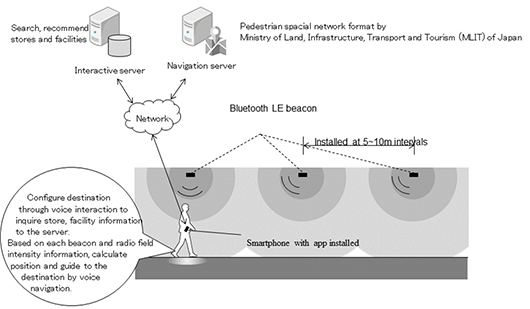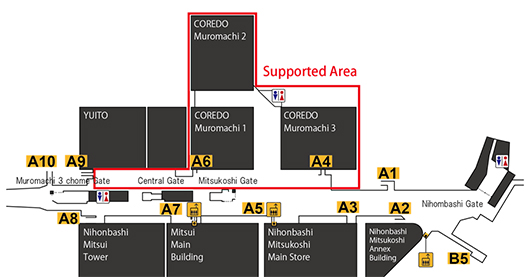Field Experiment of High Precision Voice Navigation System in Nihonbashi Muromachi District
Creating Barrier Free, Stress Free Neighborhoods
January 26, 2017
Shimizu Corporation
IBM Japan, Ltd.
Mitsui Fudosan Co., Ltd.
Tokyo, Japan, January 26, 2017 - Shimizu Corporation, IBM Japan, Ltd. and Mitsui Fudosan Co., Ltd., announced the launch of a field experiment to test the efficiency of an experimental high precision indoor/outdoor voice navigation system that uses a smartphone app to provide guidance on stores and facilities to visitors as part of its objectives to help realize barrier-free, stress-free (*1) neighborhoods. The field experiment takes place at the supported area comprised of COREDO Muromachi 1-3 in the Nihonbashi Muromachi district, part of the underpass connecting to Mitsukoshi-mae Station on the Tokyo Metro Ginza Line, and the Edo Sakura Dori Underpass. The experiment takes place over three weeks from February 8 to 28, 2017.
The system has been jointly developed by Shimizu Corporation and IBM Japan. It is designed to utilize an experimental high precision indoor/outdoor voice navigation system that uses location information based on beacon signals, along with cognitive technologies (*2) to direct visitors to respective destinations comfortably and appropriately, in Japanese or English, including visitors who use wheelchairs or people with visual impairment.
In Japan, directions and guidance using indoor location information are being experimented at Tokyo Station and Narita Airport by the Ministry of Land, Infrastructure, Transport and Tourism, and at Umeda underground shopping area by the Ministry of Internal Affairs and Communications, among other places. Meanwhile, Shimizu Corporation and IBM Japan have been developing technologies to provide voice navigation both indoors and outdoors, giving consideration to individual characteristics, such as visual impairment. The development is based on accessibility and high precision indoor/outdoor location measurement technologies. This collaboration led to the development of the indoor/outdoor voice navigation system in July 2015. It has undergone series of testing towards practical use at a permanent experiential facility within the Shimizu Corporation’s lab facility in Tokyo.
At the same time, Mitsui Fudosan has been promoting an urban smart city model project in collaboration with local government and the community in the Nihonbashi area, and has been actively investigating the use of ICT in neighborhood creation.

Click illustration to enlarge
Future Development
Feedbacks from the field experiment participants with regard to location accuracy, voice guidance timing, ease of understanding, and appropriateness of the information provided will be gathered through questionnaires. Feedbacks will be analyzed to help make further improvement to the system. Shimizu Corporation, with a cooperation from IBM Japan, will aim at implementing the indoor/outdoor voice navigation system in facilities where unspecified numbers of people gather, such as airports, with a hope to demonstrate Japanese barrier-free, stress-free neighborhood creation technology to the world towards 2020. Mitsui Fudosan will utilize systems such as these to promote the creation of neighborhoods that are considerate of diverse visitors and scenarios, such as working, living, leisure, and rest, striving to enrich lifestyles and enliven neighborhoods.
Reference
Outline of Field Experiment
| Field experiment project name |
Field experiment of high precision indoor/outdoor voice navigation system in Nihonbashi Muromachi District |
| Experiment Outline |
Using smartphones to provide visitors with directions and guidance to stores by voice and navigation maps. Participating tenants are 92 stores (all tenancies in COREDO Muromachi 1-3). |
| Period |
February 8 - 28, 2017
*Field experiment for people with visual impairment took place from February 1 to 7 in which approx. forty people participated. |
| Participation Method |
Participants download navigation app called “NavCog” from App Store to their smartphone and connect their smartphone to the trial system to try out navigation in COREDO Muromachi during the field experiment period, and answer to a questionnaire.
*Field experiment for people with visual impairment took place from February 1 to 7 in which approx. forty people participated. |
| Participation Conditions |
- Users of iPhone 6 or later (iOS10 or later, except for iPhone SE) who have agreed to the terms and conditions specified separately for the field experiment.
- Participants must bear telecommunications charges incurred by downloading and using the navigation app through mobile or Wi-Fi Internet connection (no extra charge for the app).
|
| Supported Area |
A total of approx. 226,000 ft2 (approx. 21,000 m2) including the Nihonbashi-Muromachi underground mall (one of the 38 Projects of the Ministry of Land, Infrastructure, Transport and Tourism’s Greater Tokyo Area Regional Plan) and COREDO Muromachi 1-3 |

Click illustration to enlarge
Glossary
*1 Barrier-free, stress free society
A concept proposed by the Ministry of Land, Infrastructure, Transport and Tourism referring to a society where everyone can travel smoothly to their destination, including foreign visitors, the elderly, and people with disabilities.
*2 Cognitive technologies
The cognitive era is an ongoing movement of sweeping technological transformation. The impetus of this movement is the emerging field of cognitive technology, radically disruptive systems that understand unstructured data, reason to form hypotheses, learn from experience and interact with humans naturally. Success in the cognitive era will depend on the ability to derive intelligence from all forms of data with this technology..